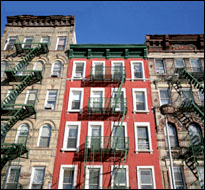
In the past 20 years, many urban U.S. neighborhoods that once had high levels of poverty and crime have grown more prosperous. According to 2013 research by the Federal Reserve Bank of Cleveland, between 2000 and 2007, 61% of Boston’s census tracts moved from the bottom half of the distribution of home prices to the top half, a key marker for gentrification. Other cities with high rates of neighborhood change included Seattle, New York City and Washington, D.C.
To preserve some stability in up-and-coming neighborhoods, some cities have started to offer long-time residents ways to reduce their property taxes, but questions remain on how gentrification really affects populations and overall prosperity. Although it is commonly believed that wealthy outsiders displace lower-income residents, little systematic research has been conducted on the question. A 2011 study published in the journal Regional Science and Urban Economics, “How Low Income Neighborhoods Change: Entry, Exit and Enhancement,” examines patterns of change in metropolitan low-income neighborhoods in the 1990s to evaluate evidence of displacement, sources of neighborhood income change and complementary changes associated with gains in average neighborhood income.
As a basis for their study, the researchers — Ingrid Gould Ellen and Katherine M. O’Regan from New York University’s Furman Center for Real Estate and Urban Policy — analyzed income changes at the household level using data from the American Housing Survey (AHS) from 1989 to 2001, tract data from the 1990 and 2000 Census, and the Urban Institute’s Neighborhood Change Database (NCBD).
The findings include:
- Original homeowners — immune from the effects of rent increases — left gentrifying neighborhoods at significantly higher rates than did poorer households that rented. The researchers suggested that relocation may be more a selective choice than a product of mounting economic pressures.
- The key drivers of neighborhood change were voluntary entries and exits — not forced economic displacement — and differences between the incomes of those moving into and out of gentrifying neighborhoods proved not to be significant.
- Households that remained in these growing neighborhoods saw much larger increases in income than comparable households in neighborhoods that did not experience such gentrification. Although these changes may not have significantly impacted a neighborhood’s average household income, “it might be an important component of the neighborhood change process.”
- Neighborhood satisfaction increased significantly among renters in neighborhoods experiencing economic growth.
- There was no evidence that neighborhoods experiencing economic growth also grew less racially diverse during that period. While 51% of new renters in these neighborhoods were white, 54% of those leaving these neighborhoods were white.
Overall, the study calls into question theories of gentrification that assume that poorer residents are simply displaced by whiter and wealthier individuals. The authors concluded that “to be sure, some individual residents are undoubtedly hurt by neighborhood change; but in aggregate, the consequences of neighborhood change — at least as it occurred in the 1990s, do not appear to be as dire as many assume.” (An open, pre-publication version of the paper is available from SSRN.)
Related research: A 2010 study published in the Journal of Urban Economics, “Who Gentrifies Low-Income Neighborhoods?” found that “the demographic flows associated with the gentrification of urban neighborhoods during the 1990s are not consistent with displacement and harm to minority households. In fact, taken as a whole, our results suggest that gentrification of predominantly black neighborhoods creates neighborhoods that are attractive to middle-class black households.”
Keywords: African-American, gentrification, creative class, local reporting, property taxes
